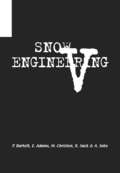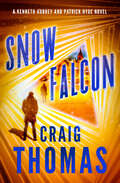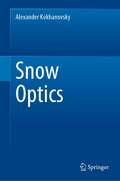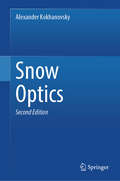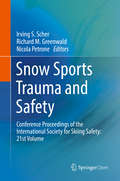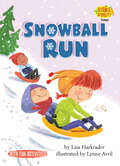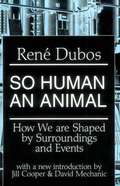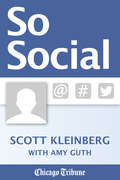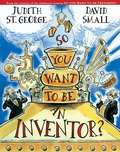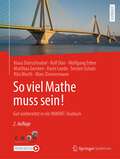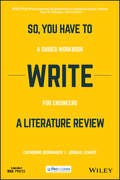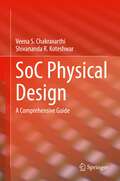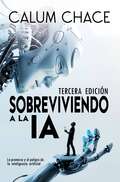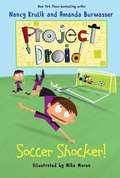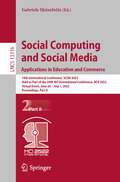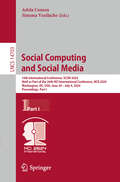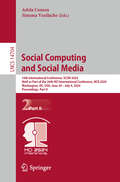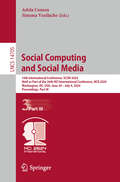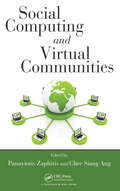- Table View
- List View
Snow Engineering V: Proceedings of the Fifth International Conference on Snow Engineering, 5-8 July 2004, Davos, Switzerland
by P. Bartelt E. Adams M. Christen R. Sack; A. SatoSpecialists in building and civil engineering, architecture, traffic and transport engineering, urban planning and avalanche science came together at the Fifth International Conference on Snow Engineering, organized by the Federal Swiss Institute for Snow and Avalanche Research in Davos 2004. This event belongs to a series of Snow Engineering Confe
Snow Falcon (The Kenneth Aubrey & Patrick Hyde Series)
by Craig ThomasNew York Times–Bestselling Author: A suddenly uninhabited Finnish village sparks a mystery—and foreshadows an epic threat . . . An international agreement to slow the arms race is in the works, but not everyone is happy about it. The KGB and MI6, with CIA support, begin to take action as suspicions about a mutiny within the Red Army swirl. Under Kenneth Aubrey&’s direction, Snow Falcon will be a high-risk mission to investigate strange developments on the frozen Finnish border, while Russian intelligence officers embark on the dangerous task of identifying plotters within the military. And if they don&’t succeed, the consequences could be dire for multiple nations . . . &“Complex, brisk . . . Solid.&” —Kirkus Reviews &“When it comes to keeping the story moving and stoking up the excitement, Mr. Thomas knows his business.&” —The New York Times
Snow Optics
by Alexander KokhanovskyThis book is the first book of its kind, focusing exclusively on the optical properties of snow. As a complex and turbid medium, snow is approached as a strongly light-scattering (in the visible spectrum) medium with large, nonspherical ice grains. The book discusses both experimental and theoretical results, as well as the remote sensing of snow using ground-based, airborne and satellite optical instrumentation. The book will be of particular importance for researchers studying snow characteristics (the size of grains, snow pollution and albedo) using various remote-sensing techniques.
Snow Optics
by Alexander KokhanovskyThis book is the first book of its kind, focusing exclusively on the optical properties of snow. As a complex and turbid medium, snow is approached as a strongly light-scattering (in the visible spectrum) medium with large, nonspherical ice grains. The book discusses both experimental and theoretical results, as well as the remote sensing of snow using ground-based, airborne and satellite optical instrumentation. The book will be of particular importance for researchers studying snow characteristics (the size of grains, snow pollution and albedo) using various remote-sensing techniques.
Snow Sports Trauma and Safety: Conference Proceedings of the International Society for Skiing Safety: 21st Volume
by Irving S. Scher, Richard M. Greenwald and Nicola PetroneThis book is open access under a CC BY-NC 2.5 license. This book covers the latest in snow sport epidemiology, snow sport injuries and treatment, and biomechanical/mechanical engineering related to snow sports injuries (mechanisms of injury, injury prevention by equipment design, injury prevention by design of resort features, and more). It brings together a collection of papers from the International Congress on Ski Trauma and Safety (the biennal meeting of the International Society for Skiing Safety) and presents the latest research on the effectiveness of winter sports equipment, the behavior of winter sports participants, and the epidemiology and biomechanics of winter sports injuries. This is an ideal book for researchers and professionals working in the field of sports medicine and safety. This book also: Covers the latest body of literature dealing with safety in winter sports as well as the prevention and treatment of injuries sustained by participants in these activities Broadens readers’ understanding of snow sport injury prevention research Illustrates ways safety standards for snow sports can be improved based on evidence-based research.
Snowball Run: Pulleys (Science Solves It!)
by Lisa HarkraderThe Science Solves It! series merges fiction and science in storylines that intrigue kids and encourage them to observe, investigate, predict, and experiment! Young readers ages 5–8 will be inspired by the relatable characters in each story as they solve kid-sized mysteries and dilemmas. Whoosh! Nothing is better than sledding down Snowball Run. But when Emmie's little brother gets tired, she has to think of a way to help him up the hill—without wearing herself out first! "These offerings confirm that fiction is a good vehicle for conveying science concepts to children." —School Library Journal (on the Science Solves It! series)
Snowbots
by Aaron Reynolds David BarnedaHow do the robot children of Clackentown spend snow days? They have supersonic snowball fights, make robot angels with wing nuts moving up and down, take hot oil baths to thaw out the joints, and receive eskimo kisses on metal noses at bedtime.Author Aaron Reynolds and illustrator David Barneda team up to tell a hilarious story about two favorite subjects--robots and snow days!
So Human an Animal: How We Are Shaped by Surroundings and Events
by René DubosIn this collection of stories, the bizarre is rendered normal, the absurd hilarious and the incredible comprehensible. The re-imaginations of reality feature evocations of historical figures, over-televised game show hosts and late-night comedians.<P><P> Pulitzer Prize Winner
So Others May Live: Saving Lives, Defying Death
by Martha J. Laguardia-KotiteSo Others May Live is the untold story of the U.S. Coast Guard rescue swimmer. In startlingly clear and exceptional writing, it tells twelve heroic stories of the greatest maritime rescues attempted since the program was started in 1985. These feats, told through the eyes of the hero, reveal an understanding of how and why the rescuer, with flight crew assistance, risks his or her own life to reach out to save a stranger. The book covers diverse environments: oceans, hurricanes, oil rigs, caves, sinking vessels, floods, and even Niagara Falls. It is truly a can't-put-it-down collection.
So Over Sharing
by Elissa Brent WeissmanIn this timely contemporary middle grade novel from award-winning author Elissa Brent Weissman, two girls find their private struggles against their influencer mothers going very publicQuiet, introverted Hadley and rough-around-the-edges Willow have one big main thing in common: both their moms have gained a huge online following sharing every detail of their lives. Hadley&’s mom—Phoebe of @PhoebeAndJay fame—loves to share all the terrible, down and dirty bits about raising kids while Willow&’s mom Rosalind at the up-and-coming @MoonbeamsAndMarigold basks in the glow of motherhood. If getting all her life's moments (including an almost decade old viral potty training video) shared online isn't enough, Hadley&’s starting a new school in a new neighborhood and desperately trying to keep her mom&’s identity a secret while Willow is struggling with a recent life-changing announcement from her mom who, it turns out, is not getting out of the influencer world anytime soon. As the two girls build a friendship on a private Instagram page and share the pains of having a momfluencers, they come up against the same question—how long will they have to share their lives with everyone?
So Social
by Amy Guth Scott KleinbergSo Social is a collection of Chicago Tribune articles written by social media experts Amy Guth and Scott Kleinberg. It explores the benefits and dangers of social media from both professional and personal standpoints. For anyone interested in growing their social media following, understanding web marketing, or keeping accounts secure, So Social is a must read. In So Social, Guth and Kleinberg give insider tips on how to use social media safely and easily for business and at home. Entrepreneurs and media mavens alike will appreciate their useful insights on Facebook, Twitter, Instagram, Vine, LinkedIn, Google+, Pinterest, and more. Each platform has a dedicated chapter, which is beneficial to both social novices and media experts. The Internet is awash with advice and lists of varying quality on improving social media habits. So Social has set itself apart by being a carefully curated collection from two tech gurus with experience across media platforms, from traditional "old-world" publishing to disruptive new media technologies. A quick yet highly informative read, So Social will be a crucial tool for any reader looking to improve their social media approach.
So You Want to Be an Inventor?
by Judith St. GeorgeA spirited and witty look at history that focuses on the inventors and inventions who have given us lightbulbs, automobiles, and all the other things that keep the world humming.
So funktioniert Mediation im Planen + Bauen: Mit Fallbeispielen und Checklisten
by Peter Hammacher Ilse Erzigkeit Sebastian SageKonfliktbegleitung und Konfliktlösung im Planen und Bauen außerhalb der Gerichte ist erfolgreich und notwendig. Das Buch zeigt die Voraussetzungen und Wirkungsweise der Mediation anhand vieler Praxisbeispiele aus dem öffentlichen und privaten Baurecht. Alternativen der außergerichtlichen Konfliktlösung werden vorgestellt, etwa die Experten-Schlichtung oder die Adjudikation zwischen Baubeteiligten und - ganz aktuell - die Bürgerbeteiligung bei öffentlichen Vorhaben.Der Leser findet umfassende Erläuterungen, aber auch Interviews, Dialoge und Fallstudien zu unterschiedlichsten Themen rund um das Planen und Bauen.
So funktioniert Mediation im Planen + Bauen: Praxis der Konfliktbearbeitung ohne Gericht
by Peter Hammacher Ilse Erzigkeit Sebastian SageKonfliktbegleitung und Konfliktlösung im Planen und Bauen außerhalb der Gerichte ist erfolgreich und notwendig. Das Buch zeigt die Voraussetzungen und Wirkungsweise der Mediation anhand vieler Praxisbeispiele aus dem öffentlichen und privaten Baurecht. Auch andere Alternativen der außergerichtlichen Konfliktlösung werden vorgestellt, etwa die Experten-Schlichtung, Adjudikation, VOB/B-Stelle, Schiedsverfahren zwischen Baubeteiligten und Mediation, Moderation und Bürgerbeteiligung im öffentlichen Bereich. Die Konfliktlösung durch die Gerichte, einschließlich Güterichter und einstweiliger Verfügung werden ebenfalls einbezogen. Der Leser findet umfassende Erläuterungen, aber auch Interviews, Dialoge und Fallstudien zu unterschiedlichsten Themen rund um das Planen und Bauen.
So viel Mathe muss sein!: Gut vorbereitet in ein WiMINT-Studium
by Klaus Dürrschnabel Rolf Dürr Wolfgang Erben Matthias Gercken Karin Lunde Rita Wurth Marc Zimmermann Torsten SchatzMithilfe dieses Arbeitsbuches können sich Studieninteressierte auf die mathematischen Herausforderungen in einem WiMINT-Studium vorbereiten. Kurze, verständlich formulierte Texte frischen Schulwissen wie logisches Begründen, Bruchrechnen, Differentialrechnung oder lineare Gleichungssysteme wieder auf. Hierbei helfen eine Vielzahl an Beispielen und Aufgaben mit Lösungen sowie Selbsttests am Anfang jedes Kapitels, mögliche Stolperfallen schon frühzeitig zu identifizieren. Thematisch orientiert sich das Arbeitsbuch am sogenannten cosh-Mindestanforderungskatalog, welcher von Lehrenden aus Schule und Hochschule gemeinsam entwickelt wurde. Dieser hält nach übereinstimmender Meinung vieler deutscher Hochschulen, Dachverbände und Hochschullehrenden das für ein WiMINT-Studium notwendige mathematische Vorwissen fest. Neben allgemeinen mathematischen Kompetenzen werden elementare Algebra, Geometrie, Analysis, lineare Algebra und analytische Geometrie sowie Stochastik abgedeckt.
So, You Have to Write a Literature Review: A Guided Workbook for Engineers (IEEE PCS Professional Engineering Communication Series)
by Catherine Berdanier Joshua LenartIs a literature review looming in your future? Are you procrastinating on writing a literature review at this very moment? If so, this is the book for you. Writing often causes trepidation and procrastination for engineering students—issues that compound while writing a literature review, a type of academic writing most engineers are never formally taught. Consider this workbook as a "couch-to-5k" program for engineering writers rather than runners: if you complete the activities in this book from beginning to end, you will have a literature review draft ready for revision and content editing by your research advisor. So, You Have to Write a Literature Review presents a dynamic and practical method in which engineering students—typically late-career undergraduates or graduate students—can learn to write literature reviews, and translate genre-based writing instruction into easy-to-follow, bite-sized activities and content. Written in a refreshingly conversational style while acknowledging that writing is quite difficult, Catherine Berdanier and Joshua Lenart leverage their unique disciplinary backgrounds with decades of experience teaching academic engineering writing in this user-friendly workbook.
SoC Physical Design: A Comprehensive Guide
by Veena S. Chakravarthi Shivananda R. KoteshwarSoC Physical Design is a comprehensive practical guide for VLSI designers that thoroughly examines and explains the practical physical design flow of system on chip (SoC). The book covers the rationale behind making design decisions on power, performance, and area (PPA) goals for SoC and explains the required design environment algorithms, design flows, constraints, handoff procedures, and design infrastructure requirements in achieving them. The book reveals challenges likely to be faced at each design process and ways to address them in practical design environments. Advanced topics on 3D ICs, EDA trends, and SOC trends are discussed in later chapters. Coverage also includes advanced physical design techniques followed for deep submicron SOC designs. The book provides aspiring VLSI designers, practicing design engineers, and electrical engineering students with a solid background on the complex physical design requirements of SoCs which are required to contribute effectively in design roles.
Sobreviviendo a la IA: La promesa y el peligro de la Inteligencia Artificial
by Calum ChaceEste es el siglo de las dos singularidades: la singularidad económica (desempleo tecnológico) y la singularidad tecnológica (la explosión de la inteligencia). Ambas presentan enormes oportunidades y enormes desafíos. Si las manejamos con éxito, nuestro futuro como especie será más que maravilloso. Si fallamos, podría ser miserable, y quizás breve. El impulsor es la inteligencia artificial (IA), la tecnología más poderosa de la humanidad. El software que resuelve problemas y convierte los datos en valiosa información ya ha revolucionado nuestras vidas, y la revolución se está acelerando. En 2015, la inteligencia artificial ocupaba las primeras planas, y con justa razón. Se está acercando a un punto de inflexión en el que las máquinas pueden realizar mejor que nosotros muchas tareas que antes se consideraban exclusivamente humanas. Los sistemas de aprendizaje profundo están a punto de reconocer imágenes y comprender el lenguaje natural mejor que los humanos. El argumento de este libro es que debemos monitorear los cambios que están ocurriendo y adoptar políticas que fomenten los mejores resultados posibles. La gama de posibles resultados es amplia, desde los terribles hasta los maravillosos, y no están predeterminados. Serán seleccionados en parte por suerte, en parte por su propia lógica interna, pero en parte también por las políticas adoptadas en todos los niveles de la sociedad. La automatización y la superinteligencia son los dos desarrollos que ya podemos prever causarán grandes impactos. La automatización podría conducir a una singularidad económica y la evolución a un tipo de economía completamente diferente. Si nos equivocamos, una élite podría poseer los medios de producción y reprimir al resto de nosotros en un autoritario régimen tecnológico distópico. Si lo hacemos bien, podríamos disfrutar de una economía de abundancia radical, donde nadie tiene que trabajar para ganarse la vida, y todos somos libres para divert
Soccer Shocker!: Project Droid #2 (Project Droid)
by Nancy Krulik Amanda Burwasser Mike MoranWhen Mom tells Logan that Java is joining his soccer team, the Purple Wombats, he’s not thrilled. It’s a lot of work teaching his new robot cousin how to act like a human-and keeping him out of trouble-and Logan needs a break.Still, being programmed for success means that Java’s also great at scoring. He might just turn the Wombats into a championship team, beating Sherry and Jerry Silverspoon and their Red Polar Bears . . . if he’d just let the other kids play, too. After being replaced as the Wombats’ MVP, Logan’s had enough.But when Java gets wet and goes on the fritz, can the whole team-even a short-circuiting Java-come together to score the winning goal?The second in a fantastically funny new chapter book series by internationally bestselling author Nancy Krulik and her daughter, Amanda Burwasser, Soccer Shocker is destined to win tons of fans.Sky Pony Press, with our Good Books, Racehorse and Arcade imprints, is proud to publish a broad range of books for young readers-picture books for small children, chapter books, books for middle grade readers, and novels for young adults. Our list includes bestsellers for children who love to play Minecraft; stories told with LEGO bricks; books that teach lessons about tolerance, patience, and the environment, and much more. While not every title we publish becomes a New York Times bestseller or a national bestseller, we are committed to books on subjects that are sometimes overlooked and to authors whose work might not otherwise find a home.
Social Cognitive Radio Networks
by Xu Chen Jianwei HuangThis brief presents research results on social cognitive radio networks, a transformational and innovative networking paradigm that promotes the nexus between social interactions and cognitive radio networks. Along with a review of the research literature, the text examines the key motivation and challenges of social cognitive radio network design. Three socially inspired distributed spectrum sharing mechanisms are introduced: adaptive channel recommendation mechanism, imitation-based social spectrum sharing mechanism, and evolutionarily stable spectrum access mechanism. The brief concludes with a discussion of future research directions which ascertains that exploiting social interactions for distributed spectrum sharing will advance the state-of-the-art of cognitive radio network design, spur a new line of thinking for future wireless networks, and enable novel wireless service and applications.
Social Computing and Social Media: 14th International Conference, SCSM 2022, Held as Part of the 24th HCI International Conference, HCII 2022, Virtual Event, June 26 – July 1, 2022, Proceedings, Part II (Lecture Notes in Computer Science #13316)
by Gabriele MeiselwitzThis two-volume set LNCS 13315 and 13316 constitutes the refereed proceedings of the 14th International Conference on Social Computing and Social Media, SCSM 2022, held as part of the 24rd International Conference, HCI International 2022, which took place in June-July 2022. Due to COVID-19 pandemic the conference was held virtually.The total of 1276 papers and 275 posters included in the 40 HCII 2022 proceedings volumes was carefully reviewed and selected from 5583 submissions. The papers of SCSM 2022, Part II, are organized in topical sections named: social media in education; customer experience and consumer behavior.
Social Computing and Social Media: 16th International Conference, SCSM 2024, Held as Part of the 26th HCI International Conference, HCII 2024, Washington, DC, USA, June 29–July 4, 2024, Proceedings, Part I (Lecture Notes in Computer Science #14703)
by Adela Coman Simona VasilacheThis book constitutes the refereed proceedings of the 16th International Conference on Social Computing and Social Media, SCSM 2024, held as part of the 26th HCI International Conference, HCII 2024, which took place in Washington, DC, USA, during June 29–July 4, 2024. The total of 1271 papers and 309 posters included in the HCII 2024 proceedings was carefully reviewed and selected from 5108 submissions. The SCSM 2024 proceedings were organized in the following topical sections: Part I: Designing, developing and evaluating social media; user experience and user behavior in social media; AI and language models in social media; Part II: Social media in learning, education and culture; social media in business and ecommerce; Part III: Computer-mediated communication; social media for community, society and democracy.
Social Computing and Social Media: 16th International Conference, SCSM 2024, Held as Part of the 26th HCI International Conference, HCII 2024, Washington, DC, USA, June 29–July 4, 2024, Proceedings, Part II (Lecture Notes in Computer Science #14704)
by Adela Coman Simona VasilacheThis book constitutes the refereed proceedings of the 16th International Conference on Social Computing and Social Media, SCSM 2024, held as part of the 26th HCI International Conference, HCII 2024, which took place in Washington, DC, USA, during June 29–July 4, 2024. The total of 1271 papers and 309 posters included in the HCII 2024 proceedings was carefully reviewed and selected from 5108 submissions. The SCSM 2024 proceedings were organized in the following topical sections: Part I: Designing, developing and evaluating social media; user experience and user behavior in social media; AI and language models in social media; Part II: Social media in learning, education and culture; social media in business and ecommerce; Part III: Computer-mediated communication; social media for community, society and democracy.
Social Computing and Social Media: 16th International Conference, SCSM 2024, Held as Part of the 26th HCI International Conference, HCII 2024, Washington, DC, USA, June 29–July 4, 2024, Proceedings, Part III (Lecture Notes in Computer Science #14705)
by Adela Coman Simona VasilacheThis book constitutes the refereed proceedings of the 16th International Conference on Social Computing and Social Media, SCSM 2024, held as part of the 26th HCI International Conference, HCII 2024, which took place in Washington, DC, USA, during June 29–July 4, 2024. The total of 1271 papers and 309 posters included in the HCII 2024 proceedings was carefully reviewed and selected from 5108 submissions. The SCSM 2024 proceedings were organized in the following topical sections: Part I: Designing, developing and evaluating social media; user experience and user behavior in social media; AI and language models in social media; Part II: Social media in learning, education and culture; social media in business and ecommerce; Part III: Computer-mediated communication; social media for community, society and democracy.
Social Computing and Virtual Communities
by Panayiotis Zaphiris Chee Siang AngDue to the advancement of the Internet, online communities are gaining increasing importance in the research community. Presented from a user's perspective, this book explores the diverse application areas of social computing and online communities. A significant portion of the text focuses on real-world case studies in which user behaviors, social mechanisms, and technological issues are investigated. Drawing from computer science, information systems, and social science, the book takes a multidisciplinary approach to evaluate virtual communities. It is useful for those who construct, moderate, and maintain online communities.
